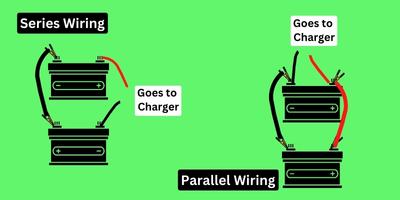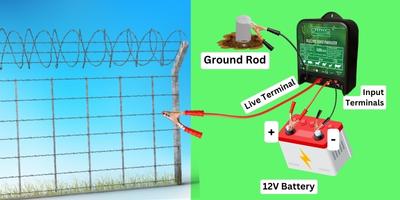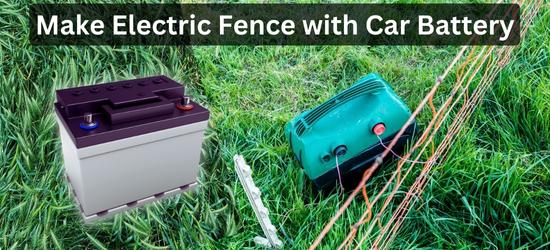To make an electric fence, you can use a car battery(12V) and a 12V fence charger that supports DC or solar power. The output voltage & power of a battery must be equal to or higher than the fence energizer/charger input power. However, you can’t use a fence charger that requires more than a car battery’s voltage or amps.
So first, ensure that your fence charger is compatible with a car battery capacity. Most 12V/ car batteries output 40-70Ah(amps per hour). Fence chargers are marked with input voltage and output joules so that you can verify your battery’s output power rating with the fence charger’s required input.
Let’s understand how to make an electric fence with a 12-volt battery.
How to make an electric fence with a car battery?
- First, compare the input requirements of the fence charger with the output capacity (Ah) of the battery. It’s better to choose a battery with voltage & capacity(Ah rating) equal to or higher than your fence charger’s needs. You can use a 6V or 12V energizer with a 12V car battery.
- Get a 12V DC or solar fence energizer that’s not an all-in-one unit (no battery already included in the circuit) and then connect the red and black leads to a car battery. To prevent the hassle of recharging the battery a solar-powered energizer is a cool option. If you want the fence to be more reliable and to survive a deep discharge without damage, use a quality 12V lithium battery. Lithium batteries(li-ion) can offer 2000+ life cycles.
- You will need a fully charged 12V healthy battery and place it near the fence charger. Connect the fence energizer’s positive input terminal to the positive terminal of the battery and the negative input terminal to the negative battery terminal.
- Then, attach the energizer’s live(+ve) output terminals to the fence wires and the ground terminal to the ground rods or any ground wire in the fence circuit.
- You can use two 12V batteries(car) & connect them in parallel in order to double up the discharge time.
Note: Positive (live) terminals on the fence charger and battery are marked with +, and negative terminals with the – sign. Make sure that circuit wires don’t touch each other.
Step 1: Connect two car batteries:
Why it’s better to use two car batteries? Connecting two 12-volt batteries in parallel increases the circuit capacity, effectively doubling the ampere-hour (Ah) rating while maintaining a 12-volt output. Hence, it’ll extend the battery timing. However, you should only connect the batteries with the same voltage and Ah rating(ampere per hour/capacity).
Having two batteries in parallel provides redundancy. If one battery fails or is depleted, the other can still supply power to the circuit.
For example, if you attach two 12V 50Ah batteries in parallel. The voltage will remain 12V, while capacity increases up to 100Ah(50+50) due to two batteries. Hence, two batteries can power the energizer twice as much as a single battery.
Check the battery health if you have an old battery:
If you are going to use an old 12V/car battery it’s better to test its health before installation. There are two ways to test a car battery.
Open Circuit Voltage Test: After fully recharging a battery, test it after a few hours. Measure the voltage of the battery without any load using a multimeter or any voltmeter. A healthy 12V lead acid battery should read around 12.6 volts when fully charged. If a recharged battery gives a voltage below 10.5-10.8 volts, it’s considered to be faulty.
Under Load: Test the voltage under a small load (like turning on headlights). A steady drop in voltage indicates potential issues. A healthy battery should maintain voltage under load for a longer duration.
The voltage of unhealthy batteries after recharging depends on the type of batteries. In the case of a 12V lithium-ion (Li-ion) battery, it typically consists of three cells in series, with a voltage of around 4.2 volts per cell. When fully charged, a healthy 12V lithium battery reads around 10 to 14 volts. However, if the voltage drops significantly below 9V after charging, it indicates deep discharge and potentially irreparable damage.

Steps to connect two 12-volt batteries:
To connect them, use high-quality insulated cables to link the positive terminal of one battery to the positive terminal of the other and, similarly, connect the negative terminals. This setup provides more power storage for applications.
- Take two same power batteries, two jumper cables with 4 terminal connectors, or alligator clips at the ends.
- Strip the wires using a wire stripper or plass & securely attach the bare ends to the terminal connector or the alligator clips. If you bought jumper cables you don’t have to do anything.
- Connect the positive terminals of both batteries with a jumper wire. Then, connect both negative terminals with the second jumper cable. Ensure the battery terminals are not loose(must have a secure connection).
Step 2: Connect batteries to the fence energizer’s input terminals:
A DC(battery-based) fence energizer has two input terminals, a positive and a negative. These input terminals of the energizers get attached to the positive & negative terminals of the battery to intake power. There could be already available leads with the energizer or you could have to arrange it on your own.
- Now, connect the batteries to the fence charger. Attach the energizer’s positive input terminal to the positive terminal of one battery.
- Then, attach the charger’s negative terminal to the negative terminal of the same battery already attached to the fence charger.
- At last, please turn on the fence charger and ensure it’s clicking.
Step 3: Connect fence energizers output terminals to the fence and ground rods:
Use jumper cables or highly conductive insulated wire to connect the energizer’s output terminals to the ground rods & live fence wires. Many 12V fence chargers have input and output cables instead of terminals. So you don’t have to buy jumper cables or alligator clips separately.
Take at least 3 ground rods for grounding. A galvanized rod is recommended to prevent corrosion. Each ground rod should be 6-8 feet long & drive them 10 feet apart from each other. A general rule is to use 3 feet of ground rods for per joule output of your fence charger. Drive the ground stake into the ground using a post driver & hammer.
Use an excellent conductive wire to connect ground rods together. Same as, connect the ground terminal at the fence charger to the ground rod(earth stake).

Similarly, use a highly conductive jumper cable or insulated wire to attach the fence energizer’s live output terminal to the fence wires.
At last, turn on your fence charger and see if it’s clicking or if the indicator light is flashing. Your fence charger should start clicking in a couple of seconds.
If the charger takes too long to start clicking or the indicator light doesn’t glow, either the battery is empty/dead or the fence charger is faulty.
Finally, use a fence tester to measure the voltage in the fence wires.
How long will a car battery power an electric fence?
The duration a car battery can power an electric fence depends on several factors, mainly on the battery’s capacity (ampere-hour rating/(Ah)), the energizer’s power output, how frequently the energizer pulses, the length of covered area, the number of strands, vegetation, and short circuit power loss.
- Battery Capacity: 12 V car batteries typically have capacities(Ah/Ampere hour rating) ranging from 40 Ah to 100 Ah. The higher the Ah rating or capacity, it can power the fence for longer. Divide the battery’s Ah rating by the energizer’s power consumption to estimate the operational duration in hours. For example, if you have a 12V battery with a 100Ah capacity rating & your energizer intakes 500mA. The battery can power the fence for 200 hours or approximately 7-8 days. Similarly, if you have a 48 Ah battery, it’ll power the fence for 95 hours or 3-4 days.
- Check the energizer’s power, usually specified in watts or joules per mile. The higher the output joules of the energizer, the more quickly it will drain the battery.
- Pulse Frequency: Consider the energizer’s pulse frequency. If the energizer pulses less frequently, it will consume less power, extending the battery life. Conversely, a high-frequency pulsing energizer will drain the battery faster.
- Temperature: High temperatures reduce lithium-ion battery capacity and lifespan, potentially causing thermal runaway, while low temperatures decrease their power output. Lead-acid batteries suffer water loss and corrosion in heat, while cold temperatures reduce their capacity, increase internal resistance, and may lead to freezing, damaging the battery. That’s why it’s recommended to place the batteries in a cool, dry place at average room temperature is ideal.
- Length of fence/wires: The length of fence wires can significantly impact the time a battery will power the fence; longer wires create higher resistance, requiring more power, which can drain the battery faster, reducing its operational duration.
- Battery State: The age and condition of the car battery also influence its ability to hold a charge. Older or poorly maintained batteries may not last as long.
However, the time may vary depending on the fencing area, load on the fence(vegetation, shorts), and the battery’s remaining health. Hence, the more a battery has to work, the shorter the life span.
My experience
As much I’ve experienced & fellow fence users have discussed a normal 12V car battery with a capacity of around 50-70 Ah can operate the fence for 2-3 days. A high-capacity battery such as a 12V 100Ah or marine battery(used to power marine & bear harsh environments) can power your fence for almost a week or more. Similarly, a 300Ah 12V battery will power the fence for longer.
If you are using a solar fence charger using a higher capacity battery i.e. 300Ah will keep your fence alive even if there is no sunlight for a couple of days. Similarly if using a DC fence charger a high-capacity battery gives you more time till the next recharge.
As discussed above how much time a 12V car battery lasts on each recharge depends on the energizer’s output power (joules), wiring length & resistance, and environmental conditions.
I would suggest you use higher-capacity, deep-cycle batteries (designed for excessive discharge and recharge) designed for heavy-duty purposes & for use in harsh weather.
Precautions: Regularly monitor the battery’s voltage or use a battery monitor to ensure it doesn’t discharge too deeply, as deeply discharging a car battery can reduce its lifespan. You’ll need extra batteries to keep your fence alive while recharging.
Frequently Asked Questions
How to make an electric fence with a 9-volt battery?
A 9V rechargeable battery can be used with 9V or lower fence chargers. For short-area coverage or portable fencing, a 9V fence energizer is useful. But you will have to charge the battery every 2-4 weeks.
Attach the positive input terminal of the fence charger to the positive battery terminal and the negative input terminal to the negative battery terminal.
Remember that you can only attach a 9V input fence charger to a 9V battery. Connecting a fence charger that operates on more than 9V input to a 9V battery will drain the battery quickly, reducing its lifespan.
Many fence chargers, like a Patriot P5 fence energizer, support AC and DC power, so you can hook them to an AC power source while recharging your batteries.
Conclusion
Making an electric fence with a car battery is as easy as connecting a battery to any power appliance. However, the main thing to consider is if the battery output is equivalent to or higher than the input required by the fence charger.
If the energizer requires more volts/amps than the battery’s output capacity, your battery may drain quickly, it’s lifecycles reduce quickly, and hence get dead too soon.
Also, check the voltage in your fence to know if it needs to be recharged.

